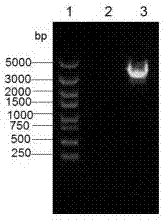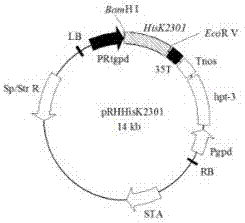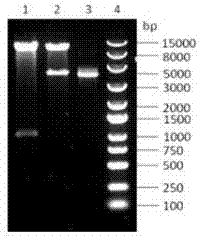Uses of histidine kinase gene Hisk2301
A histidine kinase and gene technology, applied in the field of biotechnology and genetic engineering, can solve the problems of no research reports on polyunsaturated fatty acids
- Summary
- Abstract
- Description
- Claims
- Application Information
AI Technical Summary
Problems solved by technology
Method used
Image
Examples
Embodiment 1
[0015] Embodiment 1: Rhodosporidium yeast ( Rhodosporidium kratochvilovae ) YM25235 histidine kinase gene Hisk2301 gene cloning
[0016] The total RNA of Rhodosporidium YM25235 was extracted with the OMEGA kit E.Z.N.A Fungal RNA Kit, and the cDNA was synthesized with the reverse transcription kit Takara First Strand cDNA Synthesis Kit. According to the transcriptome sequence of Rhodosporidium YM25235, specific primers (primer 1 and primer 2) were designed for PCR amplification; the primers, components and amplification conditions used in the reaction were as follows:
[0017] Primer 1: Hisk2301-F: 5'- CACACCGC GGATCC ATGCCGCAGACGCC-3' (SEQ ID NO: 3)
[0018] Primer 2: Hisk2301-R: 5’- CTGACCGC GATATC TCACTGCGGGTCGTT-3' (SEQ ID NO: 4)
[0019] ( GGATCC for Bam H Ⅲ Restriction site, GATATC for EcoR V restriction site);
[0020] The PCR amplification system is as follows (50 μL):
[0021]
[0022] PCR amplification conditions: pre-denaturation at 95°C for 5 m...
Embodiment 2
[0023] Example 2: Construction of Hisk2301 overexpression vector pRHHisk2301
[0024] Using the reverse-transcribed YM25235 cDNA as a template, using Hisk2301-F and Hisk2301-R as primers to amplify the Hisk2301 coding sequence, the obtained Hisk2301 fragment was about 3888 bp in size, and the amplified Hisk2301 fragment was subjected to Bam H I. EcoR Ⅴ After cutting with two restriction endonucleases, connect it to the expression vector pRH2304 to obtain the recombinant plasmid pRHHisk2301 (Figure 2). The obtained recombinant plasmid was transformed into Escherichia coli DH5α for amplification, and then verified by colony PCR to extract the recombinant plasmid and use Bam H I. EcoRⅤ Carry out double enzyme digestion verification on pRHHisk2301. The results showed that the recombinant plasmid pRHHisk2301 produced two bands of about 3.8 kb and 10 kb after double digestion (the second lane in Figure 3). The size of the fragments was consistent, preliminarily indicating th...
Embodiment 3
[0025] Example 3: Analysis of the relationship between the Hisk2301 gene and low-temperature synthesis of polyunsaturated fatty acids
[0026] 1. The recombinant plasmid pRH2034-Hisk2301 was transformed into Rhodosporidium YM25235 strain
[0027] The recombinant plasmid pRH2034-Hisk2301 was transformed into Rhodosporidium YM25235 strain by lithium acetate transformation method, and the transformants were selected with YPD medium containing Hygromycin B (HygromycinB) at a final concentration of 150 µg / mL; Genomic DNA PCR was used to verify the transformants .
[0028] 2. Analysis of Hisk2301 gene and fatty acid content of Rhodosporidium yeast
[0029] Two strains of transgenic Rhodosporidium YM25235 transformed into the empty plasmid pRH2304 and the recombinant plasmid pRHHisK2301 were cultured at 30°C for 24 hours, and then the cultures were immediately placed at 15°C for 24 hours for cold treatment. After the cold treatment, the fatty acids of the two transgenic yeasts were ...
PUM
 Login to View More
Login to View More Abstract
Description
Claims
Application Information
 Login to View More
Login to View More - R&D
- Intellectual Property
- Life Sciences
- Materials
- Tech Scout
- Unparalleled Data Quality
- Higher Quality Content
- 60% Fewer Hallucinations
Browse by: Latest US Patents, China's latest patents, Technical Efficacy Thesaurus, Application Domain, Technology Topic, Popular Technical Reports.
© 2025 PatSnap. All rights reserved.Legal|Privacy policy|Modern Slavery Act Transparency Statement|Sitemap|About US| Contact US: help@patsnap.com



